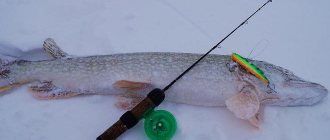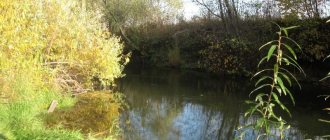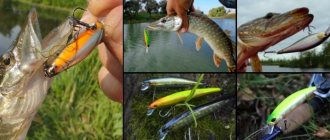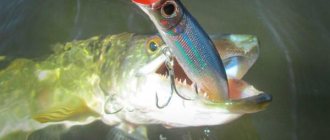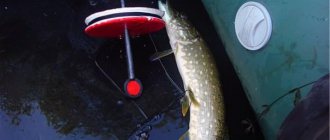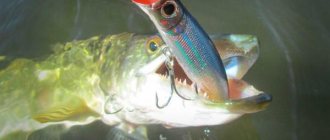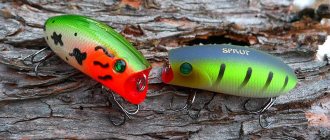Pike is a predator that lives in all types of water bodies. Basically, all fishing reports include fishing for this fish in rivers and small lakes. But this predator is also found in reservoirs and is found there in much larger quantities than on a river or lake. If you know where to look for pike in these artificially created reservoirs, you can catch a lot of fish.
Indeed, the main problem of fishing in a reservoir is finding a place for fish. If we take a river for example, then you can accurately determine the most promising places for fishing, focusing on external signs. If you find a blockage, an area with a return path, thickets of water lilies - put the right bait and catch fish! On small lakes, everything is generally simple: just fish the water area and at some point (usually almost immediately) you will get a bite. In reservoirs there are no external signs in principle; searching for pike is difficult and takes a long time. If there is an echo sounder, then the task is simplified many times over, but if this device is not there, then an angler without experience can swim the whole day without catching anything. I want to talk about those places on reservoirs that can be found without the help of an echo sounder, where a lot of pike can be kept.
Reed cut
At many reservoirs, the coastline is heavily overgrown with reeds. Many beginners try not to fish near such places and swim straight to the vast expanses of water to seek their fishing happiness. Very, very in vain. In fact, as soon as you notice reeds on the shore while sailing on a boat, immediately swim towards them to fish at their border with clear water. An underwater forest of the stems of this plant is an excellent place for a predator to ambush. Small and medium pike love to stand here. The fish stands between the stems of the reeds, with its muzzle towards the reservoir, and simply waits for the prey to swim nearby. When a fish comes into view, the pike makes a lightning-fast throw and attacks the prey. The fishing technique suggests itself: all the fisherman needs is to simply place the bait with the required degree of depth (usually up to one and a half meters) and simply move it along the wall of the reeds. In rare cases, the fish will not be particularly passive and will not bite. Most often, the pike still attacks the bait. And more than once! I was talking with a tricky guy I know, and he says that pikes can stand almost half a meter from each other!
Finding a place for catching pike with a zherlitsa
In winter, you need to look for pike in areas where concentrations of small fish are expected. These are places where there is a lot of snags or other shelters, where the water is saturated with oxygen, and there is an unusual bottom topography. They are usually found in reservoirs and other enclosed bodies of water. Fishing is often done here using girders.
In January, pike quite often stand in the snags of reservoirs and flowing dams. In many reservoirs, such as Istrinskoye, Ruzskoye, Mozhaiskoye, Ozerninskoye, Vazuzskoye, Rybinskoye, etc., you can find areas with snags or flooded forest located near the former river bed.
The movement of water in the channel well saturates the zones of the nearest water areas with oxygen. It is worth considering that if at the beginning of the winter season predator bites are often observed in the middle of a flooded forest or snags, then in January, as a rule, the pike stays nearby, in clean water, but always chooses shelter in the form of separate snags or small holes at the bottom. If you can find such places using an echo sounder or some other method, they can be very promising for setting up vents. However, fishing near snags always threatens with snags, because the cunning pike instinctively rushes into the support, therefore, when using ordinary girders, you need not to miss the moment to hook and quickly fish out. If the pike is not pulled onto the ice in time, the tackle installed even near a separate snag may become hopelessly caught, and the trophy will be lost. But when a snag does occur, you should not immediately break off the tackle. Sometimes a hooked girder left for some time unravels itself as a result of pike throwing.
Snags located on an underwater platform, in the corner formed by the edges of the main channel and tributary, are also promising for fishing. The zherlitsy here are also placed taking into account the characteristics of the snag. When fishing in such a zone, if the pike bites sluggishly and moves little, I sometimes make runs along the lines of installation of the girders to force the predator to move. Sometimes this gives a positive result, and the predator that has moved to another point suddenly finds itself biting.
Reservoirs of a special type
There are other types of reservoirs, such as the Verkhneruzskoe reservoir, where water pumping stations are forced to work throughout the winter so that water continuously flows into the Ruza-Yauza technical canal, located on both sides of this reservoir. The current here is constantly observed, and the good saturation of the water with oxygen forces the predator to behave quite actively in winter, often in an autumn-like manner. Pike in reservoirs of this type are sometimes concentrated in snags at shallow depths; at the mouths of tributaries, in shallow irrigation areas and other areas that are not entirely typical for mid-winter. The predator’s routes can also run through deeper places with complex bottom topography. However, this does not mean at all that if you go to such a body of water, you will definitely end up with a trophy. Indeed, on the Verkhneruzsky Reservoir, girders often give better results than anywhere else, but it should be borne in mind that the activity of a toothy fish can be depicted as a sinusoid: after it has filled its belly with food, the pike usually does not feed for several days.
Read: Fishing with a float in snags
In some reservoirs there are areas of snags in which there are no pike only because these areas are occupied by pike perch or burbot. For example, on the Yauzsky Reservoir, when setting up vents in deep snags, it was the latter that were most often encountered.
On the dams of rivers such as Severka and Lopasnya, a good oxygen regime is maintained under the ice (due to a noticeable current in the riverbed), which makes it possible to actively search for pike throughout the entire water area. For example, at the dam above Khatuni, the flooded river bed is quite winding. It often approaches the shore in arcs, where there are thickets of reeds, local areas of snags and other features. In the irrigation areas there are remnants of a forest that was once cleared. In some places, the wooded shore with trees fallen into the water and submerged bushes creates good hiding places for the predator. Small or medium-sized pike are sometimes caught near a tree or frozen branches of a bush that has fallen into the water and frozen into the ice, especially if it stands above a coastal cliff with a deep bottom that has some peculiarities.
In such areas, in addition to pike, it was possible to catch medium-sized chub. To catch this fish, I use sensitively tuned perch girders with equipment without a leash. You need to look for chub exits, for which you have to frequently rearrange the girders.
In January, attention should be paid to algae zones, especially in flowing reservoirs and dams. Wide “windows” among algae, thickets of pondweed, arrowhead, cattail, uruti, etc. may turn out to be promising for setting up girders, where, under favorable oxygen conditions, food items can live in large numbers, attracting schools of small fish, so there may also be predator. It is worth looking for such zones in unovergrown areas near the mouths of tributaries, next to a bed approaching algae, with dams and other hydraulic structures. Areas near the reeds growing along a narrow “shelf”, behind which there is a drop to depth, may prove to be catchy. In this case, you need to focus on algae that look quite fresh under the ice, and avoid places with rotting algae.
You need to approach a triggered girder, especially one installed in a shallow area, slowly and carefully, otherwise the passive pike may abandon the fry.
On the reservoirs of the Upper Volga cascade, some reservoirs near Moscow, as well as on large lakes in the regions adjacent to the Moscow region, in January it was possible to find pike zones near the islands. Many islands remote from the coast are bordered along the perimeter by algae (urut, mulberry and others), attracting schools of verkhovka, roach, and small perch. Numerous schools of perch gather here to hunt for fry, and pike often watch over plump stripers. The algae bordering the island grow mainly at depths of up to 1.5-2 m. But since the depths around the islands are not the same, and in some places there are small cliffs immediately behind the reeds, bays often form among the algae in which pike can stand. This predator often comes out to hunt on island shallows and spits, especially during prolonged thaws, when melt water seeps under the ice, smelling of thawed coastal vegetation. During such periods, larvae that come to life with warmth enter ice cracks and encourage small fish to feed. Their activity immediately attracts the attention of pike.
Read: Features of choosing a winter spinning rod
“Zubastaya” often stays in the straits between islands, but not everywhere. Of course, you should take into account the water level in the reservoir, which should be high. On the Mozhaisk Reservoir, for example, pike outings in December - January occur in the Krasnovidovo area, where schools of roach and perch gather in the recesses of the bottom in the strait between a small island and the shore. The weather should not be ignored either. If there is frost for a long time, the pike concentrates on the deep channel edges behind the island. A similar picture can be seen in the Vazuzsky, Yauzsky and some other reservoirs.
In January, you can fish well on some oxbow lakes and backwaters of the Oka. It is necessary to look for areas where large depths are adjacent to small ones, and install vents along the slope in a checkerboard pattern. Narrowing oxbow lakes, where narrow “shelves” of watering are adjacent to sharp drops to depth, may be promising for fishing. It is also worth looking for areas with hummocky watering, where forage fish often find food.
Sometimes a good result is achieved by installing girders over the lumpy “tables” of backwaters. There are quite a lot of them on the Oka River, and if you study their topography using an echo sounder, you can catch a lot of fish. By the way, in January, on the Tsimlyansk backwater, craftsmen consistently catch pike perch with the help of girders and balance beams.
On the narrow and long Vazuzsky reservoir, pike can be caught well from November to January on sharp slopes of the riverbed, which often go immediately from the shoreline. At one time I went to a site whose feature was a cascade-step dump. Its length along the coast was several tens of meters. It was on it, especially on the first ice, that a lot of pike gathered. Later, the bite weakened, but still in December and January it was usually possible to catch several pikes during fishing. The predator was measured, and in addition, it was possible to simultaneously catch large bream in the nearby riverbed depths, so the trips turned out to be very effective. If at the beginning of winter bites more often occurred in the zone of the first and second “shelves”, at depths of 1.5-4 m, then by the end of December and in January - at depths of 5-8 m, in the riverbed zone or near it.
Read: What to take with you on winter fishing
It was also possible to find pike dumps at the Istra Reservoir. Here, along the shore near the village of Pokhlebaiki, there is a flooded riverbed, in places heavily overgrown with reeds. In a narrow watering hole on the shore side in December - January, schools of perch of various sizes actively feed, attracting pike here. The predator, however, is usually small. At the riverbed depths, schools of roach and bream gather to bait fishermen; the “toothy” one is also partial to these fish. Therefore, when placing the girders on the pike, I usually took into account different depths here. At the same time, he installed the girders taking into account the features of the relief. If I found a “table” with an uneven bottom in an area where the channel approached a narrow bay, I placed the girders here more densely. When, along the edge of the main flooded channel, the irrigation bottom did not stand out much, he installed the girders in a checkerboard pattern: one girder for irrigation from the bank side, the other on the channel, and the spacing of the gear could be quite wide. In such cases, a couple of girders should also be installed above deep watering, but again taking into account the concentration of roach, perch or underbream.
In January–February, in many reservoirs, pike are found on deep edges distant from the shore.
For example, on the Vazuz reservoir, large pike weighing 2-6 kg could be caught by installing girders in a checkerboard pattern, capturing the upper and lower edges. The fishing depth was usually 5.5-10 m. On such edges, at some distance from the pike places, pike perch were sometimes caught. Usually the edges were not distinguished by the features of the relief, the pike simply pecked at certain points. To find the “golden point,” it was necessary to immediately drill two or three rows of widely spaced holes, and then, during the hours when pike biting activity usually falls, rearrange the girders with a certain periodicity. The January pike biting time is usually from 9 to 11 and from 13 to 14 hours. Very rarely pike is caught at night and in the evening.
In addition to the considered areas for setting up pike vents, other promising areas can be noted: • exits of tributary beds from ravines; • flooded ditches and channels, which are found in some reservoirs; • hummock zones; • holes distant from the shore; • unremarkable flat bottom far from the shore (on reservoirs and large lakes); • shallow water areas near the coastal edge (during thaw).
Features of fishing in such places are the topic of another article. In general, a detailed study of promising zones on a particular body of water always gives a positive result, and a fisherman-researcher rarely ends up without a catch.
snag
Shallow waters
All reservoirs, without exception, have shallows. I don't mean coastal areas, but large bays or huge shallow areas of the "sea" itself. The shallows are where some of the most exciting fishing can happen! The shallow sections of the reservoir operate for quite a long period of the year. Pike comes here when the underwater vegetation begins to grow wildly, and leaves only in late autumn, when this very grass disappears and the water cools down. In shallow water, in the warm season, you can count on catching both small pike and huge “mothers” weighing more than 7 kg! Shallow water fishing techniques are very diverse. A lot of materials have already been written about this with detailed descriptions of baits, their wiring and situations for use, so I don’t see any point in repeating them. Moreover, this article is about fishing spots, not techniques.
Pike where there is bait
It is traditionally believed that a hunting pike moves along a specific route that has a closed contour.
We can agree with this if we are talking about a low-flow reservoir with shelters at the bottom in the form of tubercles of algae islands and snags. On large bodies of water with a homogeneous, flat bottom, where the “toothy” has nowhere to hide, it often chooses a different tactic. Here roach, bream and other fish usually gather in large schools, and the predator always tries to stay close to concentrations of food fish. In winter, pike does not expend energy on long-distance movements when searching. Where there is nowhere to hide, it camouflages itself by freezing and merging with the bottom. The color of the pike is such that if it does not move, it is very difficult to notice it on the ground.
To calculate the habitat of forage fish in winter, you must first of all remember that under the ice it almost always stands above a hard bottom, and where the bottom is muddy, it does not linger.
On many lakes and some reservoirs, one shore is swampy and the other is hard. This is largely due to the wind rose. The windward coast erodes over time, and leaves and duckweed are carried there; it is usually shallow. Fish leave such places in the winter, since death occurs faster under the ice here. It must be taken into account that the wind changes direction depending on the season: in summer it most often blows towards the shallow shore, and in winter, as a rule, from shallow water towards the shore that is leeward in summer (with a hard bottom).
In winter, more snow usually accumulates near such a shore than anywhere else on the body of water. The ice cannot withstand the load of rapidly growing snow, especially wet snow, and cracks appear at the border between thick and thin ice. Water comes out onto the ice, which does not freeze under the snow. Near the coast, where the winds blow in winter, good conditions are created for enriching the water with oxygen. Near such a shore, where the bottom is also hard, the processes of decay are insignificant. A lot of forage fish are suitable for “live” water; they often choose such an area for permanent residence in winter, and the pike stays here for a long time.
Water area near the islands
Many reservoirs have islands. Very small pieces of land in the middle of the water are excellent places for catching pike. And not only that, but since the article is devoted to catching toothy fish, we will build on this. Islands are natural formations, elevated areas above the water. Few people know, but near islands on reservoirs there is usually a very interesting topography, there is somewhere to hide from a predator, so there are a lot of white fish here. But the pike has a place to camouflage and something to eat, which is why it is found in abundance near the islands. Found an island?! Give him a lot of attention. Fish everything within a 100 m radius of the island. You will definitely be surprised how much fish there is in these places.
These are just some of the places where pike can hang out. In order to detect predators more effectively, you should get an echo sounder. This device will show all promising places and even where the fish are! I would also like to note this: if you don’t have a boat, then it’s better not to go to the reservoir for pike. This trip will be of little use. It would be much better for you to devote your time to some river or lake. And for shore fishing in the reservoir, it is better to go for perch or small pike perch. No tail, no scales!
What to use to catch pike in summer
In different reservoirs, pike have their own preferences; in some they bite on live bait, in other reservoirs on wobblers. Summer fishing requires the right choice of gear.
You can hunt for pike in reservoirs using different gear. Most often used:
- spinning;
- float rod (caught with live bait);
- slingshots, mugs (supplies), summer girders;
- bottom gear;
- fly fishing
Effective fishing options are: spinning fishing and mug fishing.
For spinning
Spinning is the most popular method of fishing for pike. Since pike are not particularly active in the summer, the right solution would be to use stepped wiring. This will interest even the most passive fish. It would be good to take several types of bait with you and choose the best option already on the pond. Wobblers and spinners show good results. You can try jig and trolling.
Photo: pike summer
On a float rod for live bait
The float rod is simple and effective. It shows excellent results when fishing in thickets. You need to choose rods of medium length, this will allow you to have good control over the bait and reach the right place. Since pike is a strong fish, wind the fishing line with a reserve on the reel to avoid breaks when fishing. You need to choose live bait from the fish that live in the reservoir where you are going to catch pike.
Mugs, summer dresses, etc.
Catching pike with mugs is a very successful way. When fishing with hooks, you don’t need to know the exact location of the pike. The gear itself will find the predator’s sites. For equipment, use a wooden circle, pre-painted white on the bottom and red on top. When the current is strong, baitfish are placed by the lips, and when the current is weak, by the gills. To prevent strong currents from carrying away the gear, you can use an anchor.
Many people also use converted winter poles and all kinds of self-catching devices (slingshots, bottle fishing, etc.) to catch pike.
About

